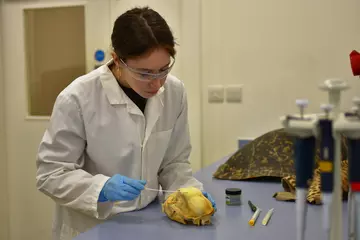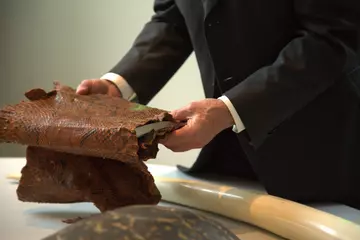
Alexandra Thomas
PhD Student
Louise Gibson
Bats & Bugs Project Manager and ZSL Biobank Manager
Wildlife crime remains one of the greatest threats to wildlife populations around the world.
Despite a global effort to curb the problem, successful prosecution and convictions are still low, facilitated by minimal resources, corruption, and lack of evidence amongst other factors.
The use of forensic techniques, including fingerprints and DNA profiling to identify human perpetrators has been around for decades and as such there is a wealth of existing infrastructure to aid in their effective use. As evidence, they still regularly contribute to successful prosecutions and convictions for law enforcement around the world across a host of different crime types. Despite their historic role in criminal investigations, these types of trace evidence are under-utilised in wildlife crime case work.
This research aims to determine how law enforcement can leverage these crucial evidence types to identify suspects in wildlife crime cases. Whilst more traditional crime types focus on fingerprint and trace DNA recovery from weapons or windowsills, we have focused on a key repeating element that is presents in wildlife crime and is handled by perpetrators,: the wildlife itself. By applying the forensic principle that every contact leaves a trace, we investigate the potential recovery of fingerprints and touch DNA from various wildlife specimens such as furs, skins, shells, feathers, and bones.

The project evaluates the effectiveness of low-cost field deployable enhancement/recovery methods for fingerprint evidence collection, as well as various touch DNA collection methods across different types of wildlife specimens, which have been resourced from our ZSL Biobank. Our research demonstrates that certain new-generation fingerprint powders can successfully recover fingermarks of a quality suitable for forensic application from 70% of wildlife specimens tested. Similarly, we have demonstrated that touch DNA is recoverable from several types of wildlife specimens and success rate is significantly influenced by the type of swab being used. Our work highlights the need for evaluation and application of best practice methods in wildlife crimes, which may differ from standard procedures, but benefit from not requiring the development of new and costly infrastructure.

By disseminating our research to law enforcement, including the Metropolitan and City of London Police forces, we aim to build capacity and confidence within relevant practitioner and first responder groups to encourage collection of human trace evidence at wildlife crime scenes using the best techniques available to them.
ZSL is a member of PAW (Partnership for Action Against Wildlife Crime).
Wildlife crime occurs all over the world, including on our doorstep here in the UK.
If you would like to learn more about UK wildlife crime please visit the National Wildlife Crime Unit’s website.
Report a wildlife crime to your relevant force
Report a wildlife crime anonymously

Get in touch for more detail on our research and consultation services
Thomas, A., Gibson, L., McColl, S., Rae, R., Ogden, R., Dawnay, N. (2023) What is it vs Who did it? A review of the lack of human focused forensic evidence in the context of wildlife crime. Forensic Science International: Animals and Environments (4) https://doi.org/10.1016/j.fsiae.2023.100073
Science v poachers: how tech is transforming wildlife conservation (2019) Financial Times
Recovering human DNA from trafficked endangered species (2023) International Labmate
Without a trace? Not anymore... (2019) ZSL
